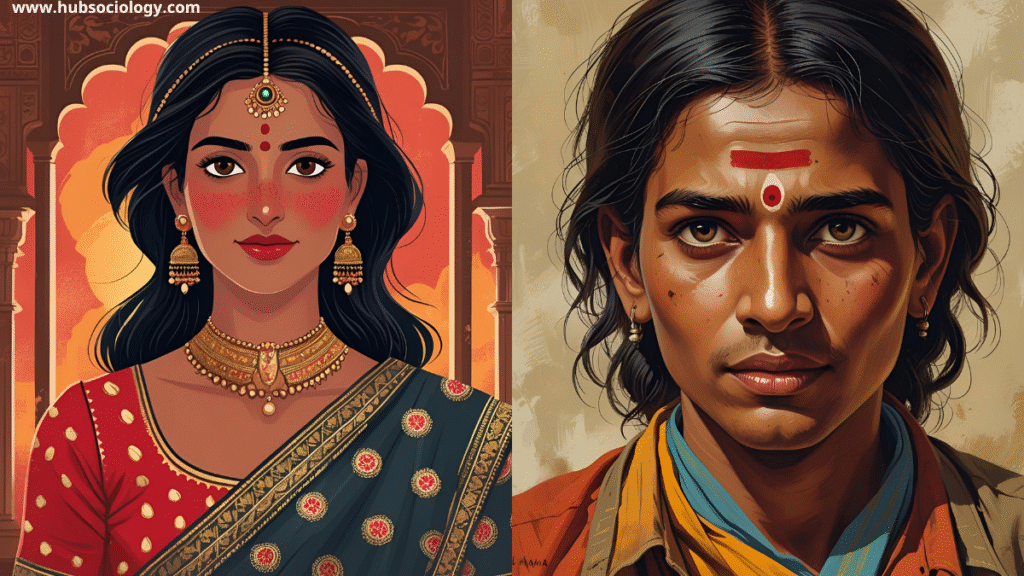The caste system in India has long been perceived by both observers and its subjects as a rigid, hierarchical, and immutable structure. The varna model—dividing society into the fourfold hierarchy of Brahmins (priests), Kshatriyas (warriors), Vaishyas (traders), and Shudras (servants), with the Dalits (untouchables) existing outside its pale—presents an image of eternal, divinely ordained social stratification. However, to view caste solely through the lens of static rigidity is to miss a crucial sociological reality: the presence of dynamic processes of social mobility within its framework. One of the most significant and widely debated concepts explaining this mobility is Sanskritization, a term coined and elaborated by the eminent Indian sociologist M.N. Srinivas.

Understanding Sanskritization: The Core Concept
In his seminal work, Religion and Society Among the Coorgs of South India (1952), Srinivas introduced Sanskritization to describe the process by which a ‘low’ Hindu caste, or tribal or other group, changes its customs, rites, ideology, and way of life in the direction of a high, and frequently, ‘twice-born’ caste.
Essentially, it is a form of social climbing where a lower caste seeks to elevate its position in the local caste hierarchy by emulating the practices of the castes it considers superior, typically the Brahmins or Kshatriyas. This emulation is not merely superficial; it involves a comprehensive adoption of:
- Ritual Practices: Embracing vegetarianism, teetotalism, and purity-pollution norms observed by the higher castes.
- Religious Beliefs: Abandoning local deities and folk traditions in favour of Sanskritic, Puranic gods like Vishnu and Shiva and adopting Brahmanical rituals and festivals.
- Social Institutions: Modifying family and marriage customs, such as enforcing stricter norms on widow remarriage, adopting dowry practices instead of bride price, and enforcing seclusion (purdah) of women.
- Lifestyle and Symbolism: Adopcing sacred threads, changing dietary habits, using Sanskritic prayers, and even altering caste names to sound more prestigious.
It is critical to note that Sanskritization is not about individual mobility but about the collective mobility of an entire caste or sub-caste group. The group mobilizes itself, often over a generation or two, to shed its ‘low’ status markers and present itself as more refined and deserving of a higher social standing.
The Sociological Drivers and Mechanisms
Srinivas located the impetus for Sanskritization within the inherent competitive nature of the caste system itself. While the system ideologically denies mobility, the practical reality of social life creates avenues for it. Several factors facilitate this process:
- Economic and Political Ascendancy: Often, a lower caste would first achieve economic prosperity through land ownership, trade, or new opportunities provided by colonial administration or modern education. Political power through numerical dominance in democratic systems (e.g., gaining political office) further bolstered their confidence. However, economic and political power alone were insufficient without commensurate ritual status. Sanskritization became the cultural strategy to convert economic capital into social and symbolic capital.
- The Role of the Dominant Caste: Srinivas observed that the process was most frequently directed towards the lifestyle of the locally dominant caste (a caste wielding preponderant economic and political power in a village). If the dominant caste were Kshatriyas or Vaishyas, the emulating group would adopt their Kshatriya or Vaishya traits, not necessarily Brahminical ones. This nuance highlights that the process is about emulating power and prestige, not just ritual purity.
- Collective Endeavour and Identity: The entire caste community would act in concert. They would hold meetings, pass resolutions banning practices deemed ‘low’ (like eating meat or offering animal sacrifices), and impose sanctions on those who broke the new codes. This was a strategic effort to forge a new, respectable collective identity.

Critiques and Limitations of the Concept
While Sanskritization provided a powerful tool to understand change within a seemingly static system, it has been subject to rigorous critique from various sociological perspectives:
- It Reinforces Hierarchical Values: The most potent criticism is that Sanskritization is not a challenge to the caste system but its affirmation. By accepting the superiority of Brahminical norms, lower castes implicitly endorse the very value system that legitimizes their oppression. It seeks a better position within the hierarchical ladder but does not attempt to break the ladder itself.
- Brahminical Bias: Critics argue that the concept over-emphasizes the Brahmin model. As Srinivas himself later acknowledged, Kshatriya, Vaishya, and even models from other religions (Westernization) could serve as reference points. Furthermore, it ignores the vast and rich cultural traditions of lower castes and tribes, deeming them inferior and something to be abandoned.
- Neglect of Structural and Economic Factors: Early formulations of Sanskritization focused heavily on cultural imitation. Critics pointed out that without changes in the structural distribution of resources, land rights, and access to education, mere imitation could only bring limited, localized status gains. A caste might become more ‘Sanskritized’ but still be denied access to temples or water sources by the traditionally higher castes.
- Alternative Paths: Westernization and Democratic Politics: Sanskritization is not the only path to mobility. M.N. Srinivas also wrote about Westernization—the adoption of modern values, education, technology, and lifestyles derived from Western contact. This often provided a more direct route to economic advancement and social reform, sometimes bypassing Sanskritic models entirely. In the post-independence era, political mobilization and assertion based on caste identity (e.g., the Dalit-Bahujan movements) have become a more powerful tool. Instead of emulating the upper castes, these movements challenge their hegemony, celebrate lower-caste culture, and use constitutional safeguards and political power to demand rights and dignity.
- Gender Implications: The process of Sanskritization often had a profoundly negative impact on women. Adopting upper-caste norms frequently meant imposing stricter controls on women’s mobility, enforcing patrilineal codes, and replacing more equitable customs (like widow remarriage) with restrictive ones, thereby reducing their social and sexual freedoms.
Sanskritization in the Contemporary Context
The relevance of Sanskritization in modern India is a subject of debate. The classic, village-based process may have diminished, but its logic persists in new forms.
- Caste and Class Nexus: The aspiration for a “Sanskritized” lifestyle is now often intertwined with middle-class aspirations. The display of ritual purity, elaborate weddings, and religious observance becomes a marker of class status as much as caste status.
- Political Symbolism: Politically powerful OBC (Other Backward Class) groups often engage in what has been termed “Kshatrization”—asserting a warrior-king identity, building temples to “low-caste” kings, and rewriting genealogies to claim Kshatriya status. This is a strategic use of Sanskritization for political legitimacy.
- Market and Media: Consumer culture and mass media often propagate upper-caste, “sanskari” (cultured) models of behaviour, influencing aspirations and lifestyles across the caste spectrum.
However, the contemporary era is also marked by a powerful counter-movement: De-sanskritization. Led by anti-caste thinkers and movements, this involves a conscious rejection of Sanskritic Brahminical values and a revitalization of subaltern cultures, histories, and identities. It represents a radical departure from the emulative model of mobility towards an assertive one.
Conclusion
Sanskritization remains a foundational and indispensable concept in Indian sociology. It successfully shattered the myth of the caste system’s complete immutability, revealing the complex and dynamic interplay between ritual status, power, and economics. It showed how social change could be initiated from below within the traditional framework.

Yet, its limitations are equally instructive. It exposes the tragic paradox of a mobility that reinforces hegemony. The critiques of Sanskritization have paved the way for understanding more radical and transformative processes of social change, such as Westernization, political assertion, and the ongoing struggle for social justice. Ultimately, the story of Sanskritization is not just about the past; it is a lens through which to understand the continuing negotiation between tradition and modernity, emulation and assertion, and hierarchy and equality in the intricate tapestry of Indian society. It reveals that mobility within the caste system is a continuous, complex, and often contradictory struggle for power, dignity, and recognition.
Do you like this this Article ? You Can follow as on :-
Facebook – https://www.facebook.com/hubsociology
Whatsapp Channel – https://whatsapp.com/channel/0029Vb6D8vGKWEKpJpu5QP0O
Gmail – hubsociology@gmail.com
Topic Related Questions
For 5 Marks (Write in about 50-80 words)
These questions typically require definitions, brief explanations, or listing points.
- Define the concept of ‘Sanskritization’ as introduced by M.N. Srinivas.
- List any five characteristics of the process of Sanskritization.
- What is the role of the ‘Dominant Caste’ in the process of Sanskritization?
- Differentiate between Sanskritization and Westernization in one point.
- Briefly state the primary objective a lower caste group aims to achieve through Sanskritization.
For 10 Marks (Write in about 150-200 words)
These questions require a detailed explanation, discussion of features, or a comparative analysis.
- Explain the concept of Sanskritization and discuss its key features as a process of social mobility.
- “Sanskritization is a form of social change within the framework of the caste system.” Elaborate on this statement.
- Discuss the various models (reference groups) that a lower caste can emulate through the process of Sanskritization.
- How does economic and political power act as a catalyst for the process of Sanskritization? Explain.
- Critically examine the concept of Sanskritization. Highlight any two of its major limitations.
For 15 Marks (Write in about 250-300 words)
These questions require an in-depth analysis, a critical evaluation, or a discussion with contemporary relevance.
- Critically evaluate the concept of Sanskritization as a process of social mobility. To what extent does it challenge or reinforce the caste system?
- Compare and contrast Sanskritization with Westernization as processes of social change in Indian society. Which one, in your opinion, has had a more transformative impact and why?
- “Sanskritization is not a challenge to the caste system but its affirmation.” Discuss this critique in detail. How have alternative paths like social justice movements provided a different route for mobility?
- Analyze the changing relevance of Sanskritization in contemporary Indian society. Discuss its manifestations in the context of politics, class, and identity assertion.
- Examine the gender dimensions of Sanskritization. How does the process of emulating upper-caste norms impact the status and freedoms of women in the mobilizing group?
